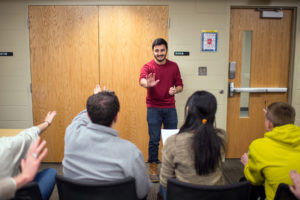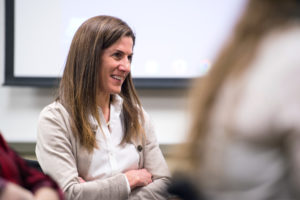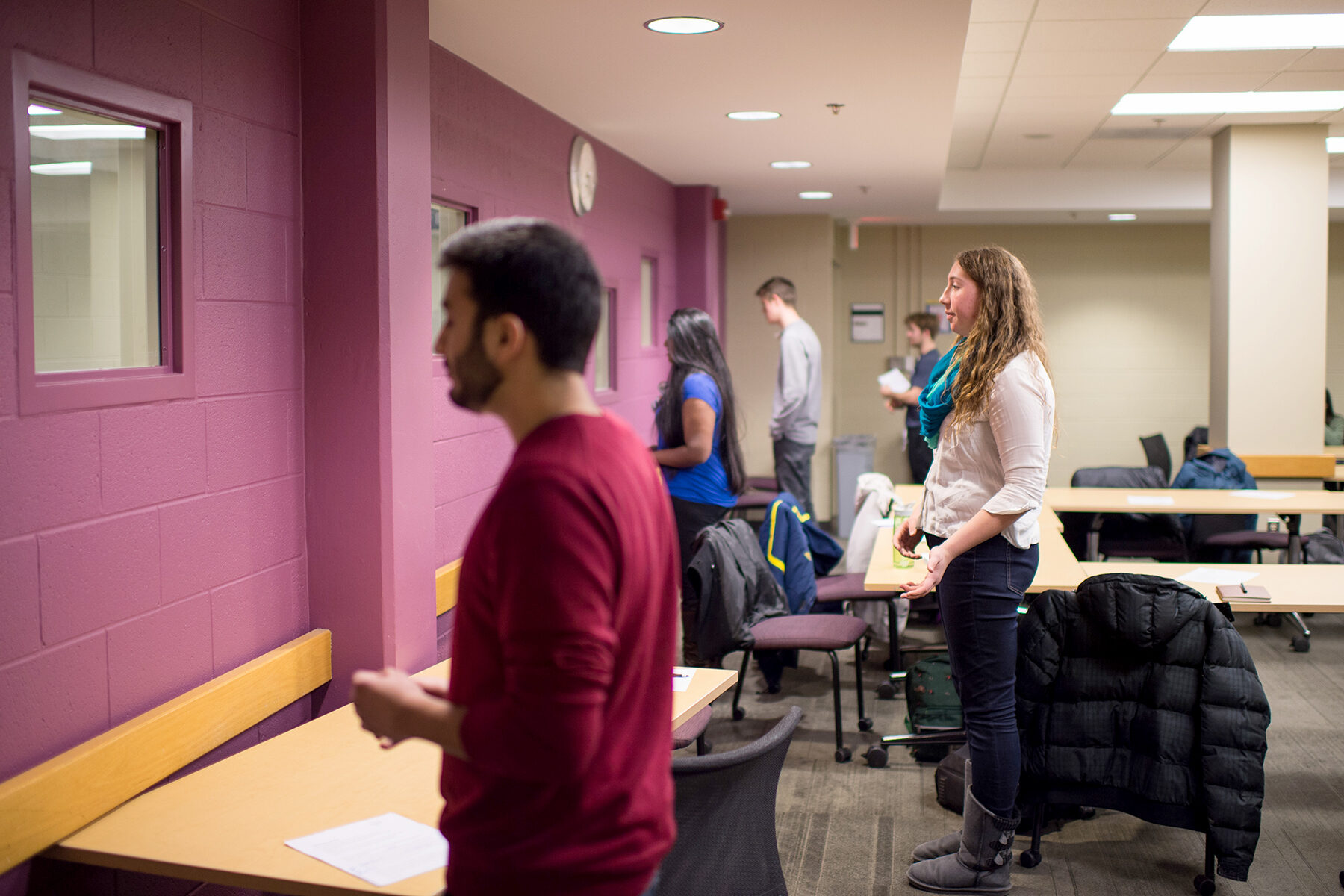
Amar Ambani, Hayley Rogers, Sneha Rajen and Tom Kidd address the wall, as they practice their Ted Talks.
It was a slightly bizarre scene. On a recent Thursday, students stood facing—and talking engagingly to—the blank wall in classroom 2011 in the University of Michigan Modern Languages Building.
“Is it possible to be true to myself and be a leader,” one student asked, “without social expectations holding us back?”
“At the end of the day, they were all going home, so I really felt lost,” another student several feet away intoned. “A job application is not supposed to cause an identity crisis, right?”
Across the room, a third student said, “A lot of the kids were really great, but there were the kids – I’ll call them the Clint Eastwoods of the class…. They refused to eat their snack….”
“I want to introduce you to the world of cybernetics,” another student announced cheerfully to his section of the wall.
If you think this sounds a little like self-guided therapy, you aren’t too far off. These students were practicing the first three minutes of their 10-minute “TED Talk,” which they were to deliver at a public showcase in two weeks.
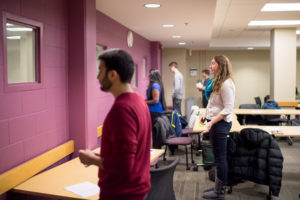
Amar Ambani, Hayley Rogers, Sneha Rajen and Tom Kidd address the wall as they practice their TED Talks.
The work was the only assignment for a new U-M mini-course called “How to Give the Talk of a Lifetime.” But that one assignment takes eight weeks to produce.
For those unfamiliar with the dynamic innovation known as “TED Talks,” the acronym “TED” stands for “technology, entertainment and design.” The phrase refers to a certain kind of “talk,” as opposed to a “speech,” the latter of which implies a more formal product, and, so often, one that has been assigned—thus engendering little excitement and rote performances.
TED Talks are the antithesis of such “speeches,” which is why they are popular all over the world and online.
TED Talks commonly are described as “ideas worth spreading,” says Anne Curzan, Arthur F. Thurnau Professor of English and associate dean for Humanities in the College of Literature, Science, and the Arts.
She is the course’s faculty sponsor.
“The TED Talk is a concrete model of a kind of talk that people watch for entertainment, that is very polished, tends to use stories well and has a clear takeaway.”
In a nutshell, these are talks given by anyone–from experts to rookies–anywhere about anything. The key is that the subject is always something the TED speaker is passionate about and wants to share with the world; hence the TED Talk approach.
Curzan delivered a TED Talk, for example, two years ago. It was titled “What Makes A Word Real?” and has had some 1.3 million views.
This novel approach to information-sharing began with the first TED conference in 1984 and has spread, especially with the advent of the Internet. Local TED groups add the “x” after the acronym and the place. The TEDxUofM group has been on campus for about seven years. It was this local group that led to the creation of this mini-course.
Sophomores Lalitha Ramaswamy, political science and international studies, and Sophia Svoboda, microbiology, both were TED Talk fans and active in U-M’s local group. Both observed the enthusiasm of students attending the annual, all-day TED Talk conference on campus.
But, Ramaswamy says, “I felt that so many of the students being inspired by the conference didn’t have an avenue to do anything with that inspiration, and all those phenomenal ideas worth spreading that were generated sadly died out within the week.”
She and Svoboda put their heads together and came up with the idea of a workshop, and developed a detailed plan for its contents. They then asked Curzan if she would be the faculty sponsor, “and there was no way I would turn this down,” Curzan says.
But she suggested they pitch the workshop to LSA administrators as a one-credit mini-course instead. Jeff Sorensen, co-founder of optiMize, was enlisted as a sponsor as well, and the mini-course was a reality.
The class was offered to students at all levels and of any major. This led to a nice mixture of freshmen to seniors, aged 18 to 22, who are majoring in everything from business to Biopsychology, Cognition, Neuroscience (BCN); there are a few undeclared students as well.
The students’ TED Talk topics are equally diverse and bear witness to the open subject format. Along with those cited above, students are examining such topics as the result of people taking photos of everything rather than being present in the moment; the power of asking questions of others to help make them feel seen; the pressure of being perfect in high school; and the health benefits of standing up instead of sitting all the time.
“So the students are reaching deep,” Curzan observes.
But unlike the free-for-all approach to topics, TED Talks follow certain guidelines, or practices, Curzan says, so that they succeed in capturing most any audience. A series of special guests each week during the course had helped students reach this goal.
The day students practiced their TED Talks they had listened to Barbara Ebeling, a drama expert, who offered a variety of gestures, intonation and breathing exercises that enhance both verbal and non-verbal performance.
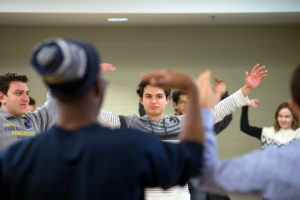
Shean Krolicki, center, Mohamad Bazzi, left, and William Royster, facing away from the camera, warm up during the session with Ebeling.
Other guests have addressed the purpose and goals (the “takeaway”) of the talk; translating ideas into words; and ensuring talks are persuasive and accessible to a general audience. The course description promises students will gain “lifelong, cross-disciplinary skills in public speaking, idea development and presentation.”
With just two weeks left in the course, students enthusiastically agreed they had gained these, and many other, skills.
“Public speaking tends to scare me, so I wanted to take a class that would allow me to tackle this fear,” says Brittani Wei-Ling Chew, the BCN major. “I learned about controlling the pace, tone and pitch of voice, structures that work well with the story telling, and the opportunity to ask questions to great orators. I would recommend this class to anyone who wants to let their ideas be known or wants to improve public speaking.”
Says Hayley Rogers, an undeclared major, “I have learned a lot about how to communicate more effectively. Even more importantly, I have learned a lot about how to express my passion.”
An obvious benefit to the class is how the skills learned here will transfer into the workplace. “We have been told by nearly every single guest speaker,” Ramaswamy says, “that being able to communicate effectively, confidently and efficiently is a skill so valued in the workplace, that oftentimes employers will hire a good public speaker over someone with a more impressive resume but who has poor communication skills.”
For her part, Curzan agrees with all of the above, and more. “The students are putting so much work into these talks. And it’s not about the grade. This class is my most fun two hours a week. It’s very inspiring to me.”

